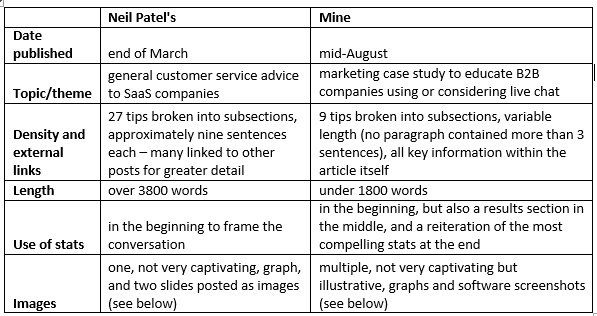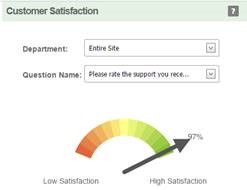
In less than eight days, my guest post on The Daily Egg (the blog of Crazy Egg) inspired 20% more shares than a post that had been up for more than 20 weeks by Crazy Egg co-founder Neil Patel (respected blogging and digital marketing guru).
Screenshot taken August 18, 2015
How could this happen? That Neil Patel guy is smart.
Don’t for a minute think that my success was an accident or coincidence (though, in fairness, I didn’t alert Neil that I made a competition out of it). Read on for how you might replicate it.
Why it’s a big deal to beat Neil Patel
A quick clarification before we get into the meat of it: This post is a compliment to Neil Patel – I’m using his work as a frame of reference because he is so successful in content marketing. Not only did he co-found The Daily Egg, he also co-founded KISSmetrics and Quicksprout, and has been recognized by the top business media as an influencer and expert in digital marketing. I use Neil as the bar for success.
It’s worth noting that, while I beat this single post from Neil in March on The Daily Egg, a June post left my August post in the dust – not to mention the scores of other posts he’s written on other sites (or just on other days of the week on the Daily Egg blog) with even greater numbers of shares.
What made my post more effective?
To understand how to replicate this success, we need to look at the differences between my post and Neil’s. (Note: This analysis isn’t a scientific study but an example of a single post from Neil when compared to a single post from me.)
Let’s analyze each category a little more:
- Date published – The timing is probably a strike against me rather than a point in my favor because more people take vacation in August than in March.
- Topic/theme – I targeted a niche industry, while Neil appealed to a broader base.
- Density and external links – Neil’s post was more of a compilation post, whereas mine was a targeted, standalone piece.
- Length – Neil’s post was twice as long as mine.
- Use of stats – Neil used statistics at the beginning but never employed them again; my post used stats throughout.
- Images – Neil included images, but they are weak. My images weren’t that much better, but they were purposeful and scattered throughout the post for visual diversity.
Sample images from Neil’s post:
Sample images from my post:
In general, my post was more accessible and actionable because it was more concise, self-contained, and targeted. It also had greater credibility and momentum behind it (more stats throughout the post and stats that were more specific, as well as better example images – though Neil’s post was probably too general to accommodate example images meaningfully).
I would characterize Neil’s post as a “skim-these-things-to-consider (also check out all of our other great content)” post whereas mine was more of a “here’s-exactly-what-you-need-to-do-this-well (with proof)” post.
You would think that Neil’s post is more broadly relevant and therefore more share-worthy (especially when coupled with his target audience, SaaS companies), however, in reality it seems that it was just too diluted to be a compelling “share” on its own.
Why did I stop worrying and my network grew?
Content quality is only a fraction of what’s responsible for making a guest post highly shared. There’s also content promotion or content distribution, which some say should consume four times more of your effort than the time you expended to create the content. This is not to be confused with the other 80/20 rule of content (we marketers love our 80/20 rules).
I can’t speak to what Neil did to promote his March post, but for my post:
- I shared it on our company’s social media – as a frame of reference, our Twitter account has between 1,200 and 1,300 followers.
I imagine this is more a strike against me than a point in my favor if Neil promoted his post through his social media channels across the several companies with which he is connected.
- I retweeted the tweets and retweets of those with significant followings who shared the post’s link (including Crazy Egg’s tweet on the day it was posted). I did this more for relationship-building reasons than I did it to affect the August post itself.
If these retweets are counted as shares by Crazy Egg’s social share widget, they artificially inflate my post’s performance by less than 10 shares.
- I sought relevant companies to share the post via their own social media and/or link to it from their blogs.
This, I think, is probably the biggest differentiator, but it was also the most labor intensive. I found about 20 relevant companies and blogs, identified the most relevant author, looked up the author on LinkedIn, and sent an invitation to connect (if I couldn’t find the person on LinkedIn, I sent an email). In the invite, I noted that I had a case study that the author’s readership might find valuable but couldn’t share a link to it in the initial LinkedIn invitation to connect. The majority of people (more than a dozen, between LinkedIn and email) accepted my invitation and were receptive to the case study link in my subsequent message.
- I looked at other high-performing Crazy Egg posts and tried to identify on what sites and social media accounts they were shared, and conducted outreach to those outlets/influencers. Many had shared my post, but I gave a nudge to those who hadn’t.
The vast majority of this outreach occurred with new relationships. However, despite the cold outreach, I got the shares I needed – and even got a job offer (talk about an effective blog post). (For the curious, I did not pursue the content manager offer because I think there’s more opportunity for me in my current role.)
All of that said, unfortunately, I don’t have the tools to determine why my post was so much more popular on LinkedIn than Neil’s single post (80-plus shares for mine vs. just over 40 for his), but that is surely a relevant factor on the content promotion side as well.
I would appreciate your suggestions in the comments for how to create or get access to a person/account-level report on who shared a link originally posted by someone other than yourself on LinkedIn.
How can you beat Neil, too?
You might not be able to beat a post from Neil – he’s damn good at his job. But if you’re going to have a fighting chance at surpassing Neil Patel, here’s a review of what worked for me:
- Length – Keep the post long enough to be substantial, but not so long that your audience gets lost in it – 1,300 to 1,700 words is a good target range.
- Topic – Pick a specific topic so you can provide relevant, concrete examples and craft a self-contained post (i.e., minimize links to other articles for the “how-to” parts).
- Images – Your images don’t have to be pretty, but tie them closely to your content.
- Content – Include both statistics and images at several points throughout your post to reinforce your message and keep your audience engaged.
- Distribution – It’s helpful but not necessary to have a strong social media and influencer network before you post, but it’s absolutely necessary to take your post to market once it’s live – many companies are starved for quality, non-self-promotional content
Best of luck in beating Neil.
Looking to score big points with your target audience? CMI’s 2016 Content Marketing Playbook has tips, insights, and ideas that can help increase your success with 24 of the top content marketing tactics.
Cover image by Ryan McGuire-Bells, DesignGratisography, via pixabay.com








